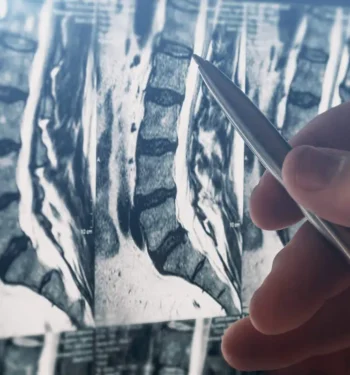
Introduction: What Is Spinal Stenosis?
Spinal stenosis is a condition where the spinal canal narrows, putting pressure on the spinal cord and nerves. This narrowing can cause discomfort, pain, and a variety of symptoms that may impact daily life and mobility. Understanding the stages and symptoms of spinal stenosis is essential for recognizing when to seek medical help and ensuring the best outcomes for yourself or your loved ones.
In the early stages of spinal stenosis, symptoms can be subtle or even go unnoticed, but as the condition progresses, the challenges can intensify. Early intervention and accurate diagnosis play a powerful role in halting or slowing down the progression, preserving both function and quality of life. By staying informed and attentive to bodily changes, you become your own best advocate in the journey towards spinal health.
Recognizing spinal stenosis stages and symptoms early not only provides peace of mind but also allows time for a proactive care plan. With each stage, the symptoms and risks change, so regular checkups and open dialogue with your healthcare provider are vitally important. Do not ignore persistent back pain, unexplained numbness, or weakness. These can be early signals that your spine needs attention and care.
If you or a loved one are experiencing symptoms or have concerns about spinal health, ask your doctor about Goodman Campbell. Their expertise in diagnosis and innovative care ensures you receive a thorough evaluation and a personalized plan, guiding you every step of the way toward better health and renewed hope.
What Are the Four Stages of Spinal Stenosis?
Understanding the four stages of spinal stenosis can provide a clear roadmap for what to expect and how best to take action at every point in your spine health journey. Each stage brings its own unique set of symptoms and risks, making early recognition and intervention especially critical. By navigating each phase with confidence, you and your family can advocate for timely treatment, protect your quality of life, and empower yourselves with hope and practical solutions.
Stage 1: Early or Mild Spinal Stenosis
The earliest stage of spinal stenosis often presents with very subtle signs. Many people notice only occasional back discomfort, mild stiffness, or a general sense of fatigue after activity. These minimal symptoms are easy to overlook but are valuable signals from your body. At this early stage, addressing lifestyle factors — such as posture, exercise, and weight management — can help slow the progression of the disease. Open communication with your healthcare team ensures any new symptoms are addressed efficiently, so be proactive and ask your doctor about Goodman Campbell for a comprehensive evaluation and guidance.
Stage 2: Moderate Spinal Stenosis
As spinal stenosis progresses into stage 2, symptoms typically become more noticeable and frequent. You might experience increased back pain, tingling, or numbness in your limbs, along with some stiffness or difficulty standing and walking for prolonged periods. These changes can impact your day-to-day activities and can gradually diminish your independence. Early intervention through physical therapy, gentle exercise, or medical management becomes especially important in this stage, and specialized experts like those at Goodman Campbell can tailor care to your particular situation.
Stage 3: Severe Spinal Stenosis
Severe spinal stenosis is marked by intense pain, significant mobility reduction, and frequent numbness or weakness in the arms, legs, or both. Daily routines become more challenging, and quality of life can suffer. Loss of balance or coordination may arise, increasing the risk of falls. At stage 3, comprehensive diagnostics and advanced therapies, including surgical consultation, are often necessary. Request an appointment at Goodman Campbell for advanced options designed to restore function and relieve pain.
Stage 4: End-Stage Spinal Stenosis
The final stage of spinal stenosis can be debilitating, with symptoms that may include loss of bowel or bladder control, muscle weakness, and even risk of permanent disability. This stage demands urgent attention, as untreated severe compression of the spinal cord and nerves can result in irreversible nerve damage. Family support and specialized neurological care make all the difference now. Guidance from trusted experts, like those at Goodman Campbell, helps ensure you have the strongest possible care plan and support network as you move forward.
Comparing Symptoms and Risks at Each Stage
Each stage of spinal stenosis brings a shift in symptoms and urgency. Early stages involve subtle discomfort, while moderate and severe stages are related to increased pain, tingling, and loss of function. Especially if left untreated, these symptoms can culminate in dramatic changes to independence and bodily control in end-stage disease. The earlier spinal stenosis is recognized, the more opportunities exist for nonsurgical treatment, so do not hesitate to request an appointment or ask your doctor about Goodman Campbell. Your journey toward hope and healing, no matter the stage you’re facing, can begin at Goodman Campbell.
How Long Can a Person Live With Spinal Stenosis?
Spinal stenosis is a challenging diagnosis, but many people with this condition live long, fulfilling lives — especially when their symptoms are managed effectively. While a person’s journey with spinal stenosis may involve periods of discomfort or reduced mobility, the vast majority of individuals do not experience a reduced life expectancy solely because of the condition. However, prompt care and comprehensive treatment are essential to avoid serious complications, particularly in more advanced stages.
How Long Can a Person Live With Spinal Stenosis?
For most individuals, spinal stenosis does not directly shorten life expectancy. With the right combination of medical care, lifestyle adjustments, physical therapy, and possibly surgical intervention, people often continue to enjoy their favorite activities, family moments, and personal growth. Early intervention and ongoing treatment are key to managing discomfort, maintaining mobility, and preventing the escalation of symptoms that can affect daily living. Regular check-ins and keeping up with recommended therapies can make a profound difference in your quality of life.
Can Spinal Stenosis Kill You?
It is very rare for spinal stenosis to be fatal by itself. Most complications arise because of untreated or advanced stages that may affect nerve function significantly. For example, severe compression of the spinal cord or nerves could lead to paralysis, loss of bladder or bowel control, and increased risk of falls or infections related to immobility. These complications are more serious in the elderly or individuals with additional health conditions, so early diagnosis and tailored care are incredibly important. The spinal stenosis death rate is extremely low, and deaths are typically linked to complications rather than the condition alone.
What Are the Serious Risks if Left Untreated?
While spinal stenosis is rarely life-threatening, neglecting its symptoms can lead to reduced function and independence. Advanced cases may cause permanent nerve damage, painful muscle weakness, or severe loss of mobility, limiting your ability to perform even simple tasks. Chronic pain and disability can also affect one’s emotional health and contribute to depression or isolation. The wonderful news is that specialists experienced with spinal stenosis and its many adverse effects can create personalized treatment plans to help prevent these risks and keep you thriving. Request an appointment at Goodman Campbell to get started on your path forward.
The Importance of Early Intervention
The sooner spinal stenosis is identified and managed, the better your outlook for a healthy, active life. With regular follow-up, guidance from specialists, and a positive mindset, you can take charge of your health journey. Supportive teams not only help manage symptoms but can also provide rehabilitation and advice for adjusting daily routines to maximize independence and well-being. Do not wait for severe symptoms to set in before you take action. Ask your doctor about Goodman Campbell for compassionate, expert care, and explore your best path forward today. Your story is still unfolding, and hope for improved comfort and mobility is within reach.
What Are the Worst Symptoms of Spinal Stenosis?
Severe spinal stenosis L4-L5 symptoms can be life-altering, presenting as intense pain, profound numbness, leg weakness, and difficulty walking. When nerve compression reaches its peak, it can lead to critical symptoms, such as sudden loss of bladder or bowel control, or even paralysis, especially if the bundle of nerves known as the cauda equina becomes compressed. Recognizing these alarming signs as urgent and seeking immediate medical attention are vital to preventing permanent disability and reclaiming your independence and quality of life.
What Are the Worst Symptoms of Spinal Stenosis?
The most severe symptoms often appear in the lumbar region at L4-L5, where the spinal canal is narrowest. Patients may experience sharp, radiating pain that travels from the lower back down the legs, making every step or movement agonizing. Weakness, tingling, and numbness may increase, causing an unstable gait and reduced confidence in daily activities. As the condition worsens, it can drastically limit mobility and independence.
Crucially, these symptoms can escalate suddenly. You may notice that you can no longer walk reasonable distances or stand for longer periods due to pain or instability. If weakness progresses or numbness spreads, it can interfere with even basic self-care. Immediate intervention can make a world of difference, so do not wait to begin your journey toward healing and pain management. Request an appointment at Goodman Campbell today to begin your path forward.
What Is End-Stage Stenosis?
End-stage spinal stenosis marks the progression where neurological compromise becomes significant, and the risk for irreversible damage is highest. This stage is characterized by severe pain, profound muscle weakness, and sometimes a total loss of function in the legs. What is even more concerning is the possible onset of cauda equina syndrome, a medical emergency involving numbness in the saddle region (inner thighs, buttocks), sudden incontinence, and potentially rapid paralysis. Obtaining help at this juncture can save a person from lifelong consequences and may restore hope for recovery.
If you or your loved one is experiencing any of these severe symptoms, including changes in urination or bowel habits, please recognize the urgency and reach out to a healthcare provider immediately. Goodman Campbell is known for rapid, expert assessment and comprehensive treatment of advanced spine disease. Your action today could be the key to preserving your strength and quality of life, so contact Goodman Campbell if you notice sudden or severe changes in your symptoms.
Is Spinal Stenosis a Permanent Disability?
Spinal stenosis can become a permanent disability if it progresses to its later stages, but many people can continue living fulfilling lives with effective treatment and support. The degree of disability often depends on how early the condition is detected, the specific nerves affected, and the success of medical or surgical interventions. For some, symptoms such as chronic back pain and mobility challenges may persist for years, while others may regain significant function with therapy and lifestyle changes.
Is Spinal Stenosis a Permanent Disability?
Spinal stenosis is not always a permanent disability. In its early stages, many patients live comfortably by adapting lifestyle habits and using conservative treatments such as physical therapy, medications, or injections. However, if left unmanaged, spinal stenosis may progress to the point where nerves are severely compressed. This can cause lasting weakness, loss of balance, and even difficulty walking without assistance. Even at the advanced stages, many individuals can still improve their quality of life through rehabilitation and careful medical management. Seeking support early and exploring all available options are crucial for maintaining independence and well-being. Remember that advances in medical and surgical treatments continue to provide hope for better patient outcomes.
What Happens After the Final Stages of Spinal Stenosis?
If an individual’s condition progresses to the final stages of spinal stenosis, they may experience significant and sometimes permanent changes in their ability to move or care for themselves. These may include chronic pain, numbness, weakness, and in the most severe instances, loss of bowel or bladder control. Despite the challenges, compassionate care, adaptive devices, and physical therapy can make a remarkable difference in a patient’s daily life.
Quality of Life and Support Resources
While the journey of living with spinal stenosis may feel overwhelming, you are not alone. Many individuals have found meaningful ways to adjust, thrive, and remain engaged in life’s joys through the right support resources and medical guidance. Rehabilitation programs, home modification, assistive devices, and community support can drastically enhance independence and happiness even with chronic back pain. Keeping a positive outlook and working closely with healthcare professionals can empower both patients and families.
If you or a loved one are facing ongoing challenges from spinal stenosis, ask your doctor about Goodman Campbell for guidance, rehabilitation, and comprehensive support to help you live your best possible life.
What Is the Single Best Exercise for Spinal Stenosis?
The search for the best exercise for spinal stenosis often centers around activities that relieve pressure on your spine and encourage gentle movement. While there is no one-size-fits-all solution, many experts recommend flexion-based exercises, such as using a stationary bike or walking while slightly leaning forward with support, as these movements open the spaces within the spine, potentially reducing nerve compression and discomfort. Choosing the right exercise can help you reclaim mobility, decrease pain, and restore hope for a more active daily life, no matter your current level of function.
Why Are Flexion-Based Exercises Often Best?
Flexion-based exercises, which encourage the spine to curve forward, may provide the most relief for those living with spinal stenosis. Activities such as stationary biking or gentle forward bends can help keep the spinal canal open and alleviate the pressure on nerves. These exercises not only minimize pain but also make it easier to maintain healthy movement patterns, support your rehabilitation journey, and enhance your quality of life.
Why Is It Important to Consult With a Specialist?
Before starting any new physical therapy or exercise regimen, it is essential to consult with your physician or a licensed physical therapist. Every case of spinal stenosis is different, and professional guidance ensures that you are performing exercises safely and effectively. Customized advice from experts — like those at Goodman Campbell — can maximize your success, prevent further injury, and give you the confidence to pursue regular movement that is right for you.
Benefits of Regular Exercise for Spinal Stenosis
Consistent, gentle exercise improves circulation, maintains muscle strength, and reduces stiffness, all vital for managing spinal stenosis. Regular physical activity supports better balance, mood, and flexibility — important components for ongoing independence and well-being. When you commit to movement and stay proactive with your health, you are taking control of your journey and giving yourself the best odds at living fully.
Ask your doctor about Goodman Campbell’s physical therapy and rehabilitation services. Support is available every step of the way to help you rediscover movement, find lasting relief, and embrace a brighter tomorrow.
Conclusion: Take Action to Manage Spinal Stenosis
The journey through spinal stenosis treatment can be complex, but you and your loved ones are not alone. Recognizing the stages and symptoms early on is the key to protecting mobility, independence, and overall well-being. Every patient’s path is unique, but with the right information and a proactive approach, you can take control of your health and future.
Early intervention and regular check-ups are crucial in preventing irreversible changes and improving prognosis. By staying vigilant and seeking guidance from a specialized care team, you empower yourself to make informed decisions at every step. Do not underestimate the power of timely action; early recognition of changes, access to rehabilitation, and personalized care can make a dramatic difference in outcome and quality of life.
Prevention is always easier than cure, and adopting small changes today can reap lifelong benefits. Whether you are at the beginning of your journey or facing advanced symptoms, remember that expert help is available. Make use of comprehensive resources, family support, and regular follow-ups with clinicians who understand the nuances of spinal stenosis treatment and the promise of new advances in care.
At the center of compassionate, expert spine care, the professionals at Goodman Campbell help countless patients find hope and return to the activities they love. If you or a family member has concerns about spinal stenosis, take the first step toward a healthier, brighter tomorrow — request an appointment or ask your doctor about Goodman Campbell, and experience the difference a dedicated team can bring to your journey toward healing and resilience.


